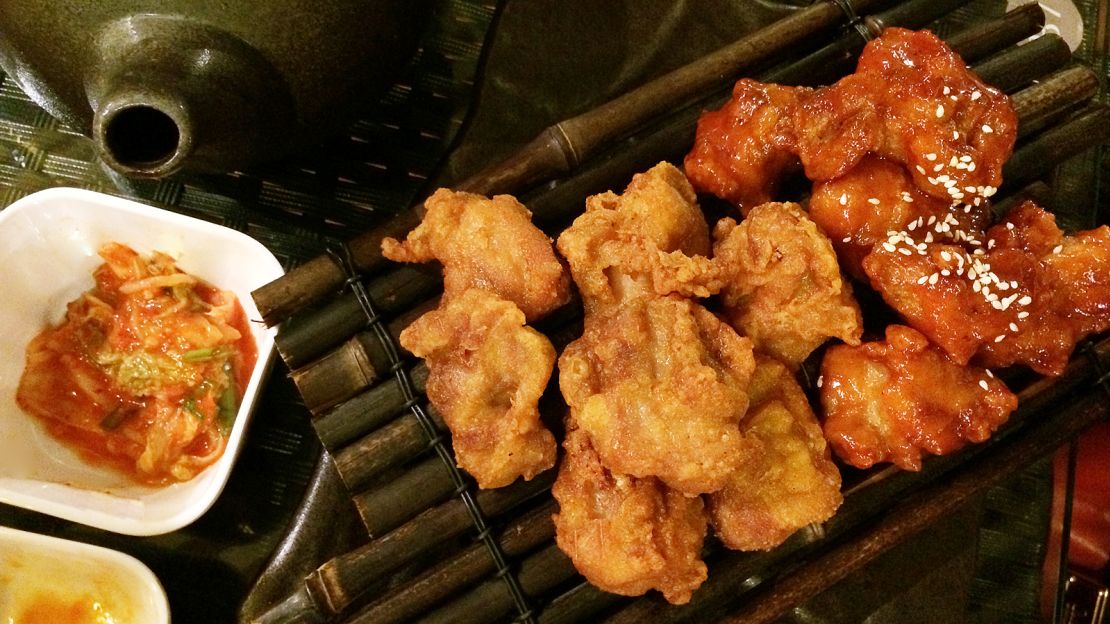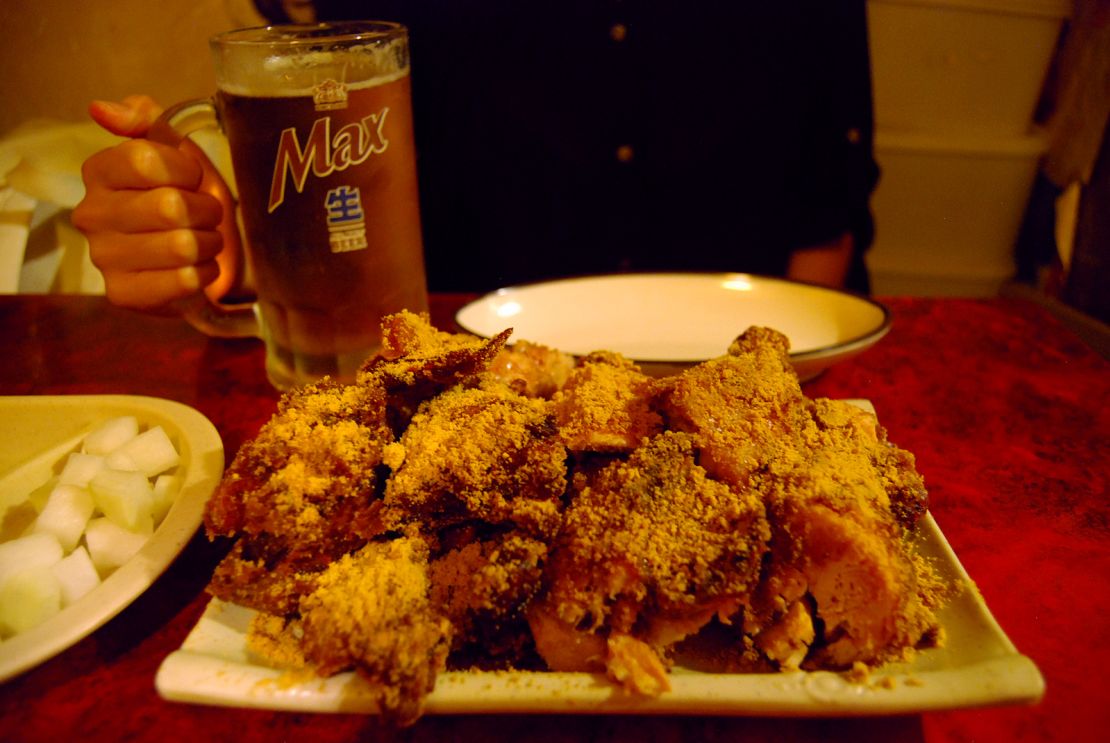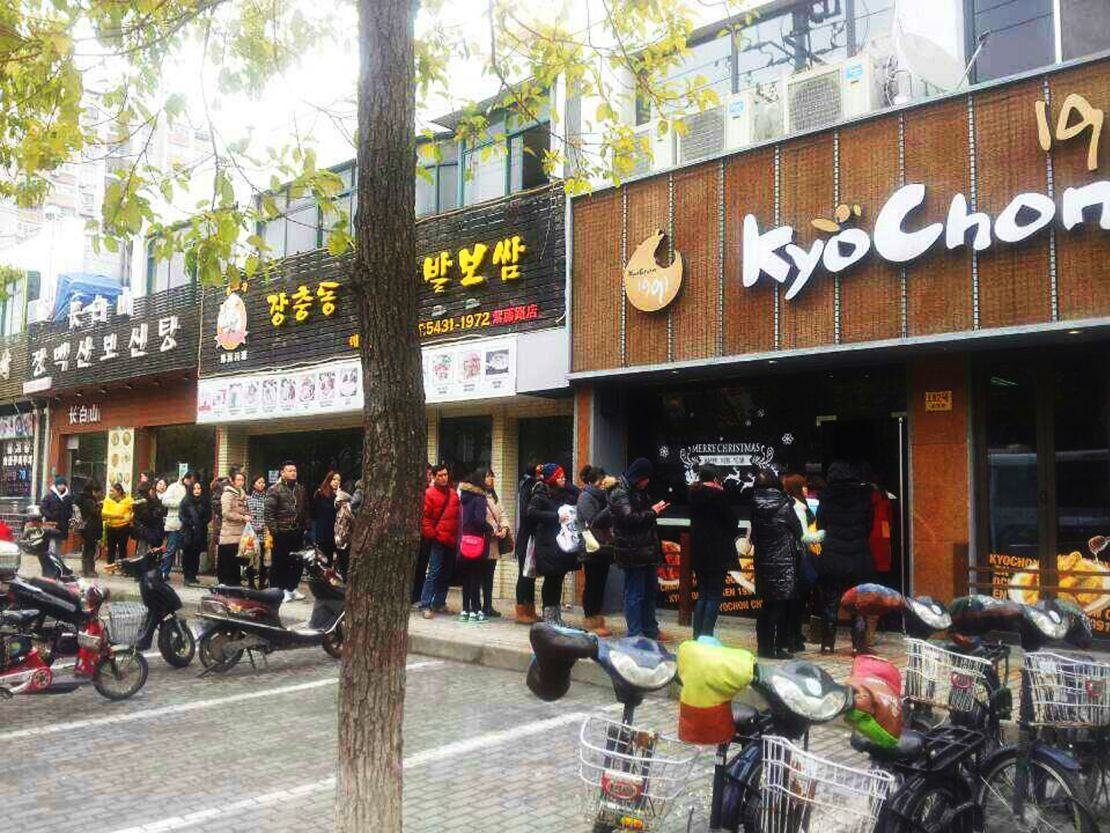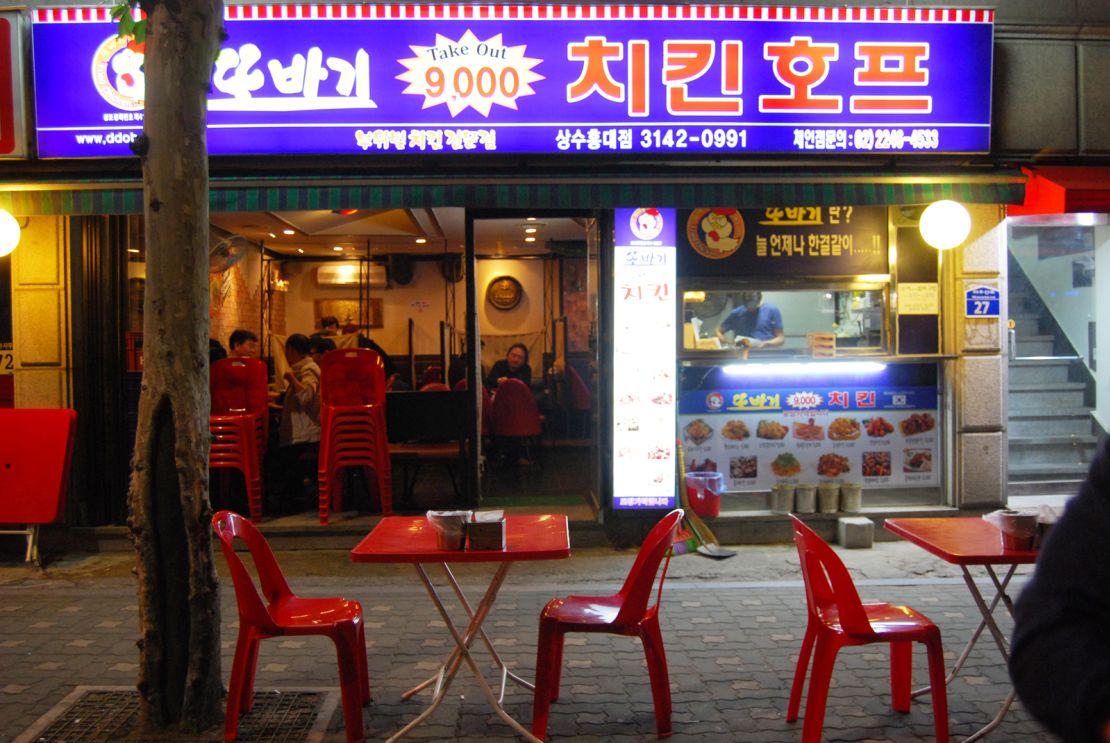Neither fried chicken nor beer originated in Korea.
But the union of these two overseas imports has become a culturally significant force in South Korean drinking culture.
The country is bursting with places to eat chicken.
As of 2013, South Korea had more than 20,000 fried chicken eateries.
The market for fried chicken is worth about 3 trillion KRW (about $3 billion), according to Statistics Korea.
There’s even a festival devoted to chicken and beer in Daegu.
Chimaek: Chicken’s Kimye and Brangelina

Like any celebrity power couple, chicken and beer have a co-joined nickname: chimaek (“chi” for chicken and “maek” for maekju, Korean for beer).
Chimaek has been around for a while but the term itself became widespread in 2010, the year of the World Cup, and something of a golden year for chimaek.
Its popularity hasn’t abated, and its significance has risen from national dish to national pastime.
“Chimaek is like a sigh of relief,” says Kim Min-jeong, who works for a legal firm in Seoul. “Chimaek after work lets me know I’ve survived another day.”
“It’s part of our national culture,” says bar owner Park Vito, who sometimes gets chicken delivered to his bar. “Chimaek is both an industry and a part of our dining culture.”
Korean-style, chimaek-worthy chicken is defined by an enormous range of choices that fall under the chimaek umbrella.
Some claim only a specific frying method qualifies as “authentic” Korean-style chicken, but there are so many chimaek styles – chicken places are forever hatching new techniques and flavor combinations – that no one really has a say on what counts and what doesn’t.
There’s proto-Korean fried chicken, the whole roast chicken (tongdak).
There’s chicken cooked on a charcoal fire (sutbul chicken).
There’s boneless (sunsal), slathered in sweet and spicy sauce (yangnyeom) and smothered in leeks (padak).
There’s no hierarchy, only a diverse range that caters to a variety of tastes.
Chicken was once considered a delicacy in Korea, stewed whole with dates and ginseng and reserved for special occasions.
Fried chicken for the masses came with the launch of the first South Korean vegetable oil product in 1971, alongside a rapidly growing chicken industry.
Fried chicken was embraced as an excellent food pairing for draft beer, and subsequent years saw the debut of multiple chicken franchises.
Their growth was bolstered by the financial crisis of the late 1990s – some who lost their jobs turned to opening chicken joints.

Global stardom

Korean-style fried chicken is becoming popular abroad.
The chimaek fever that swept through China in the past year can be traced to a line from the popular South Korean TV drama, “My Love from the Star.”
Chimaek makes frequent appearances as the favored comfort food of the drama’s heroine, who says, “It’s snowing. How can you not have chimaek?”
The show has inspired a chimaek festival in the Chinese city of Ningbo, social media memes and long lines outside of Korean fried chicken restaurants in China.
Xinhua, China’s state news agency, hailed the TV drama and the chimaek trend as a driving force in reviving chicken farms in 2014, which have suffered due to H7N9 avian flu concerns.
“Sales at the Kychon Chicken Ziteng Road location in Shanghai more than tripled over the previous year, following the success of (‘My Love from the Star’),” according to Gil Yeong-hwa of Kyochon Chicken.
“We had customers standing in line for two hours for their chicken.”
Kyochon created a stir in the domestic delivery chicken scene in 1991 with its trademark soy sauce chicken.
Today the major chain remains a favorite at home and has opened locations in the United States, China and Southeast Asia.
“The effect of the drama wasn’t as big in the U.S. as it was in China, but sales have been rising continuously,” says Gil.
“And Korean-style fried chicken is becoming more popular in the U.S. Kyochon’s garlicky, soy sauce chicken, which is different from the fried chicken they might have at KFC, for example, is getting an especially good response abroad.”
Bonchon is another Korean chicken franchise that Korean chimaek lovers might not recognize – its overseas locations (more than 150) far outnumber its two Korean locations.
But according to Lee Jin-woo, manager of the Haeundae location in the South Korean city of Busan, Bonchon’s distinctive sauce is still made in Korea and shipped to outlets around the world.
Chicken talk
Chimaek isn’t the only word that has come from the marriage of “chicken” and “beer.”
Chimaek fanatics call themselves “chideokhu,” a combination of the words “chicken” and “deokhu,” which means “maniac.”
These chideokhu might call chicken “chineunim,” “chicken” and the Korean word for “God.”
Connoisseurs who can differentiate between brands without consulting the delivery box are chimmeliers, a mishmash of “chimaek” and “sommelier.”
There’s even a chicken-specific hallelujah: chillelujah!
How to chimaek
Whatever the level of chimaek awareness overseas, it’s never a problem finding a chimaek spot in Seoul.
In fact, the sheer variety can be overwhelming.
Here are some places to start.
1. Saerona Hof

This snug chimaek spot opened in 1977 and has become the sort of place that has a wait even on weekdays.
The curry powder-topped chicken (18,000 KRW/$16) is by far the most popular and deserving item on the menu.
The flavor is enough to arouse suspicion about what other magic powders might be at work.
The effects of “My Love from the Star” were felt here also.
“But we were popular before that, too,” says owner Gang Hyeong-seok, who still fries and serves the chicken herself.
Saerona Hof, 522, Dosan-daero, Gangnam-gu, Seoul; +82 2 544 2802; open daily from 5 p.m.-3:30 a.m.
2. Sai Chicken
Long considered one of Seoul’s top chimaek spots, Sai, which means “between,” used to be tucked into a narrow alleyway in the relatively inaccessible and hilly neighborhood of Buam-dong.
There’s a second location in the slightly more accessible Hongdae area.
Both spots serve Sai’s famous set of fried chicken and sukju (green bean spout) – with beer, of course.
Sai Chicken original Buam-dong location, 1, Baekseokdong-gil, Jongno-gu, Seoul; +82 2 395 4242; opening times differ from day to day
Sai Chicken Hongdae location, 61-6, Dongmak-ro, Mapo-gu, Seoul; +82 2 6403 4242; opening times differ from day to day
3. Han River Delivery

“Chimaek with friends on the Han River in the summer makes even the heat bearable,” says Kim Ji-ha, a Seoul-based designer and chimaek lover.
“I like bicycling to the Han River, and spreading out a blanket on the grass, and getting chicken delivered in only the way you can get it delivered here in Korea – directly to the park,” says Kim.
Han River chimaek means BYOB or delivery, but you have your pick of picnic spots along the riverside, and your pick of chicken franchises.
Banpo Park is a popular spot that chicken delivery scooters know well.
The picnic delivery market is so fierce that you’ll see peddlers from nationwide franchises and neighborhood mom-and-pops handing out fliers around the park.
Han River Banpo Park, 40, Sinbanpo-ro 11-gil, Seocho-gu, Seoul; +82 2 591 5943
Kyochon Chicken, +82 1577 1991 (local calls only); open noon-11:30 p.m.
Chicken Pelicana; +82 1588 9292 (local calls only); opening hours differ by location
4. Sangsu Ddobagi Chicken

The Sangsu-dong location of the Ddobagi franchise feels like a mom-and-pop shop.
As with many neighborhood spots Ddobagi, the chicken comes with a cheap price tag.
The Ddobagi Chicken starts at 10,000 KRW ($9).
Ddobagi Chicken Sangsu/Hongdae location; 27, Wausan-ro, Mapo-gu, Seoul; +82 2 3142 0991
5. The Frypan
“The boneless fried chicken at the Frypan is (addictive),” says local journalist Kurt Achin, who has lived and eaten chicken in South Korea for the past decade.
The Frypan rose to prominence by serving chicken and beer in a bright, cafe-like environment, stepping away from the norm of cramped pubs.
The chicken tenders without bones is available at Frypan locations all over the country.
The two below are located near major universities.
The Frypan Sinchon, 23, Yonsei-ro 12-gil, Seodaemun-gu, Seoul; +82 2 393 7707; open daily 5 p.m.-2 a.m.
The Frypan Seoul National University Station,168, Gwanak-ro, Gwanak-gu, Seoul; +82 2 876 2202; open daily 5 p.m.-2 a.m.
